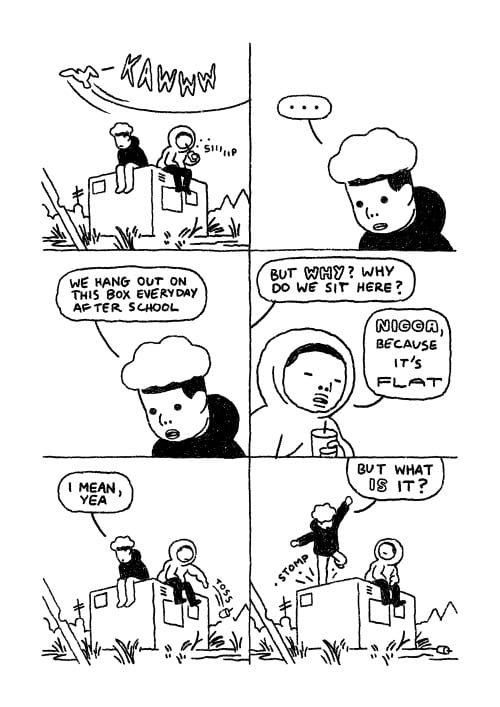That Box We Sit On from Richie Pope is the kind of comic you push, hard. Perhaps that’s why voters at the 2018 Small Press Expo named Pope the winner of the Ignatz award for Outstanding Artist. The democratic process aside, how do you express joy without tipping over into pure ballyhoo?
Start with the low-fi nonchalance and charm of That Box We Sit On, that’s the draw. Two unnamed school-age boys of color tilt at windmills imagining and interrogating the whos, whats, wheres, whys and hows of the titular box and its environs. This idyll includes spicy sunflower seeds too, snacks being an essential element to any clock-killing effort and critical analysis thereof.
That Box We Sit On has the feel of a comic a cartoonist with a handful of comics, say six or so, like Pope, creates—something light and likely personal, another, perhaps, recursive deep dive into solipsism. What keeps it from going down that self-published mini-comics superhighway is how Pope boxes himself in. Each of the comic’s sixteen pages contains a single six panel grid, for a total of ninety-six panels in all. It’s less of a gimmick and more a demonstration of Pope’s control as a storyteller not to mention the durability of his imagination and intellectual rigor. Each page tells a complete story, wheels within wheels and boxes within boxes. Every panel counts. There’s no filler. The prescriptive structure gives the narrative a meditative and qualitative quality, but never becomes a drone or pulls up short on the story’s promise. This tight-but-loose take makes That Box We Sit On open (wide open) to interruption without the loss of immediacy or the feeling that Pope’s handing out homework or slumping into nostalgia.
In less confident hands the setting could veer into the absurd—a hip-hop Waiting for Godot—if it wasn’t so recognizable and relatable. Every ‘hood, ‘burb or ol’ dirt road has some nexus of ley lines, an improvised meeting space where ‘the kids’ know to go. This any-box-in-any-empty-lot scenario gives the story its universality, a connection to the characters and “that box” regardless of social, economic or cultural circumstance. It may be Pope’s experience growing up as an African-American or not. Pope’s blackness and the fact his characters are black factors into That Box We Sit On, but this not a “black story” in that it is not one dimensional. Pope wants to ask questions other than about race. The boys talk like young black boys because that’s who they are. Their use of slang is naturalistic. They (and Pope) aren’t trying to establish their cultural credibility, blackness or age. They’re kids. Kids who imagine the box could be protection for “the hood” and “kicks out cops when they gang up to mess with people” which is a concern for people of color, but it’s only one of the acute angles, one suggestion of what “that box” could be in this prismatic story.
 For Pope’s pint-sized philosophers “that Box” is a tabula rasa. Honestly, ‘What is it?’ The better question, as they quickly suss out, is ‘what the box could be?’ There’s an ocean of difference between those two questions. And since these boys have nowhere to be (yet) the ideas flow fast. “Maybe the box makes you grow up faster,” says one. Or maybe it’s “a bug,” says his friend. To which his interlocutor replies: “that’s why we can’t stay out late.” Other suggestions are made (and rejected): wormhole, teleporter, fountain of youth, a worlds within worlds and a giant brain that controls stray dogs. “Just an endless cycle,” says the more ebullient and less chill of the two.
For Pope’s pint-sized philosophers “that Box” is a tabula rasa. Honestly, ‘What is it?’ The better question, as they quickly suss out, is ‘what the box could be?’ There’s an ocean of difference between those two questions. And since these boys have nowhere to be (yet) the ideas flow fast. “Maybe the box makes you grow up faster,” says one. Or maybe it’s “a bug,” says his friend. To which his interlocutor replies: “that’s why we can’t stay out late.” Other suggestions are made (and rejected): wormhole, teleporter, fountain of youth, a worlds within worlds and a giant brain that controls stray dogs. “Just an endless cycle,” says the more ebullient and less chill of the two.
The box, of course, is equal parts all and none of these prompts—a perpetual motion machine of metaphors and ideas. If there’s a lazy moral to glean from these takes, some ‘ice cream for bedwetters’ like ‘the only limit is your imagination,’ or ‘you can do anything you put your mind to’ Pope can’t be bothered. He’s not above playing with trite clichés, sure, but this is where the precision of his cartooning tamps down such amorphous noise.
The obvious (and most important?) question—“What if the box is just a box?”—becomes the narrative’s penultimate question, a saving throw for enlightenment, truth. At the top of page fourteen, in the upper-right-hand panel, Pope draws the box from the inside, nominal lines that look like an internet ‘hamburger menu’ preside over a jumble of paper, balls and scraps suspended in an ebony void. One boy reckons, “All the pieces of paper we slip in the box vents are still inside it.” The adjoining panel shows the outside of the box complete with a near swear, smiley and “Cool S.” Pope beats the box up some, it’s not straight-line precise, there’s a bend in the seam to reinforce how long the box has been around, perhaps as long as humans have been turning these sorts of boxes over in their minds. The graffiti and the scraps of paper form a palimpsest of existential ills, stops and starts. The middle left-hand panel looks like a how a kid would pull-off (or imagine) drawing a cube in two-dimensions. While on the right-hand side the box unfolds, the top or lid of the box ascends to possibly reunite with the mothership … of boxes. The boy says, “The sides of the box are just the sides of the box and that’s it.”
Pope provides no punctuation for these explanations/statements, only the questions receive marks. It’s an easily over-looked detail that speaks to the comic’s grace and open-endedness. It’s not meant to be deep, rather an imperfection in the beat Pope lays down—even if you miss it, you don’t miss it.
 In the bottom left-hand panel, the boy, puts his hand to his mouth and with his eyes closed, says, “mm, too real,” sans punctuation, of course. Too real. Indeed. The final panel on the page cuts from the action to a telephone pole, wires and a streetlight. Like all the other explanations, this “realness,” is found wanting. It’s less of a retreat from reality and the acceptance that reality is one option of many, more angles of the prism.
In the bottom left-hand panel, the boy, puts his hand to his mouth and with his eyes closed, says, “mm, too real,” sans punctuation, of course. Too real. Indeed. The final panel on the page cuts from the action to a telephone pole, wires and a streetlight. Like all the other explanations, this “realness,” is found wanting. It’s less of a retreat from reality and the acceptance that reality is one option of many, more angles of the prism.
That Box We Sit On testifies to imagination and improvisation, while physically the characters never leave this one spot they move through time and space, six panels at a time. These six panels in particular read as a metaphor for the act of creation and creativity, specifically creating comics or maybe even commenting on comics. All those scraps of paper ‘slipped in the vents’, the writing and rewriting and superimposing of your own marks on previous marks and the marks of others who came before you. Such navel-gazing speaks to open-ended and reflective quality of the narrative, another vacuum for all those bits of paper.
What makes the reader want to fill the void and join in on the palaver is the last panel. The telephone lines and the street light act as an invitation to send thoughts and ideas down the wire. Pope includes the streetlight as a coy way to spotlight lines of communication, to say, “go on, now, holla atcha boy.” Pope drops in these cutaways not to fill time, but to give the gift of time. Slow down. Take a breath. Rest. These panels are Pope’s punctuation—high signs to the reader to chill and dig the moment for the sake of the moment.
So when he devotes nearly a third of the narrative to show the boys stopping to snack, it’s more than a pause, it’s a deliberate break, a call to attention. Like a DJ, Pope takes all the other elements out and leaves the underlying beat, the two boys, and the percussive “krak” and “munch” of their reverie. This moment is sandwiched between the fantastical possibilities the box presents (bug, portal, mech) and its (possible) reality of being only what it is. Before the questions get to the deepest point or reach for the highest ground, Pope wants clear minds and full bellies. It’s a prescription for self-care, a road well-worn by children yet seldom followed by their older selves.
The reason you push That Box We Sit On onto others, why you rep for it, is because it doesn’t pin down what the box is let alone the “joy” it creates by being the thing it is. Pope gets to have it both ways: part arthouse head-scratcher, part crowd-pleaser. All joy.







